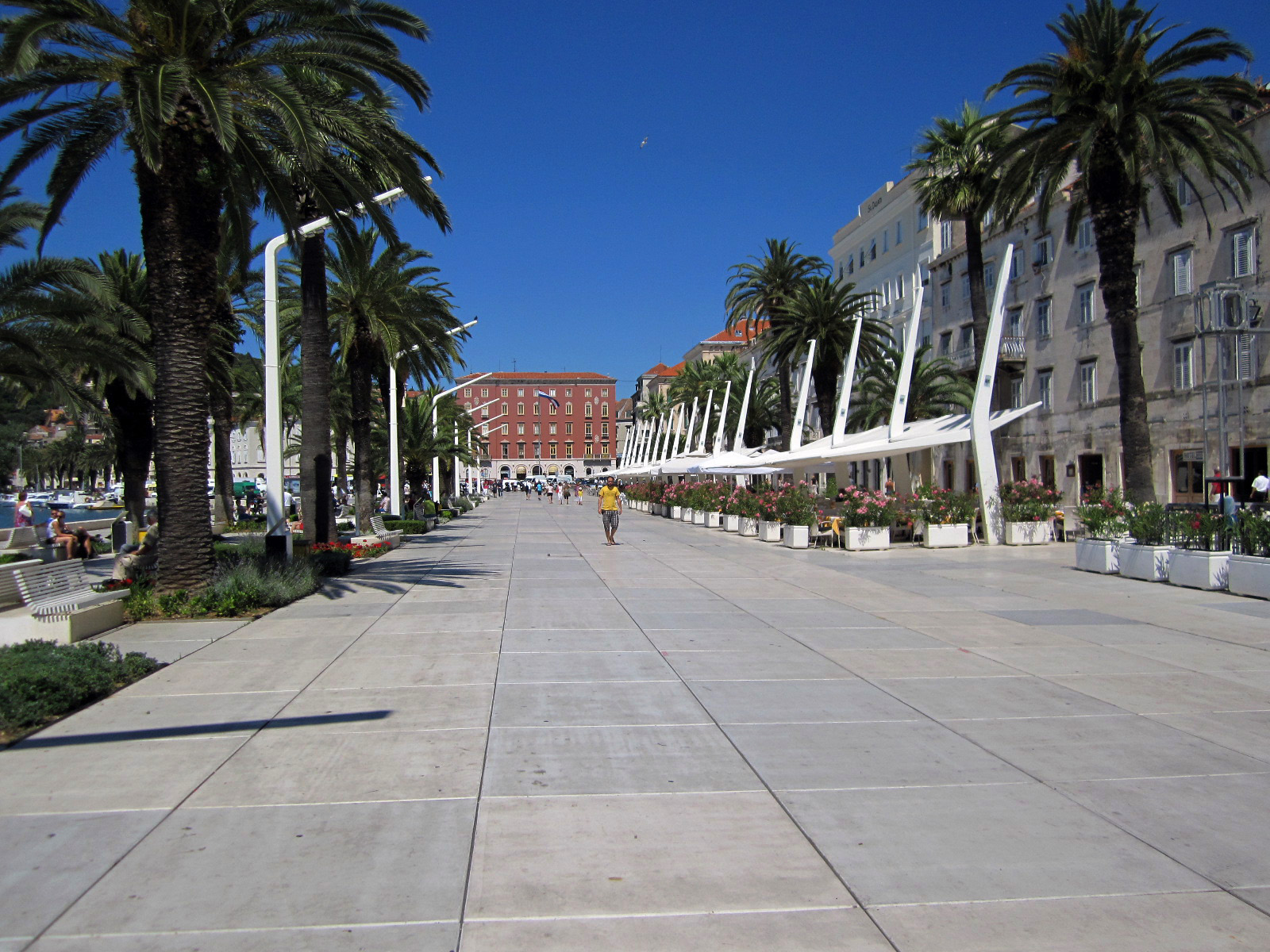 Before I get into the amazing destination of Split on the Dalmatian Coast, let me tell you that the airport is close to an hour from the old city. The cost for a cab is 336 kuna ($65). However, there is a bus transfer (run by Croatia Airlines) from the airport to the old town for around $4 per person.
Before I get into the amazing destination of Split on the Dalmatian Coast, let me tell you that the airport is close to an hour from the old city. The cost for a cab is 336 kuna ($65). However, there is a bus transfer (run by Croatia Airlines) from the airport to the old town for around $4 per person.
But anyway you can get here is worth it. This is one of the most beautiful places in the world. The Riva, the long promenade along the Adriatic sea is filled with café tables and awnings. It is the perfect pause from the heat for a cool refreshing beverage while watching the performance of people pass by. The narrow, winding white marble streets of the 13th-16th century Old Town meander through ancient houses and small shops, eventually spilling out onto the grand stone thoroughfare called the Marmontova, a promenade named for Auguste de Marmont, Napoleon’s aide-de-camp, and former Duke of Ragusa (now Dubrovnik), Governor of Dalmatia and Governor-General of all the Illyrian provinces between 1805 and 1809. He might have only ruled here for less than 4 years, but he made a big impression on the city. Our Hotel (Hotel Marmont) is also named after the General.
The big thrill of Split, however, is the enormous (710’ x 600’) 3rd century Roman Palace built by the Emperor Diocletian (284-305), who was born in Solana (now Solis), a few kilometers from old Split.
The 3rd century Palace takes over a 3rd of the old town. Built in only 10 years between 295-305 AD, it’s entirely made from white Croatian Marble. In 305, ill and tired of Roman politics, Diocletian abdicated the throne and retired here, tending his gardens. Unfortunately he only lived another 6 years at age 67.
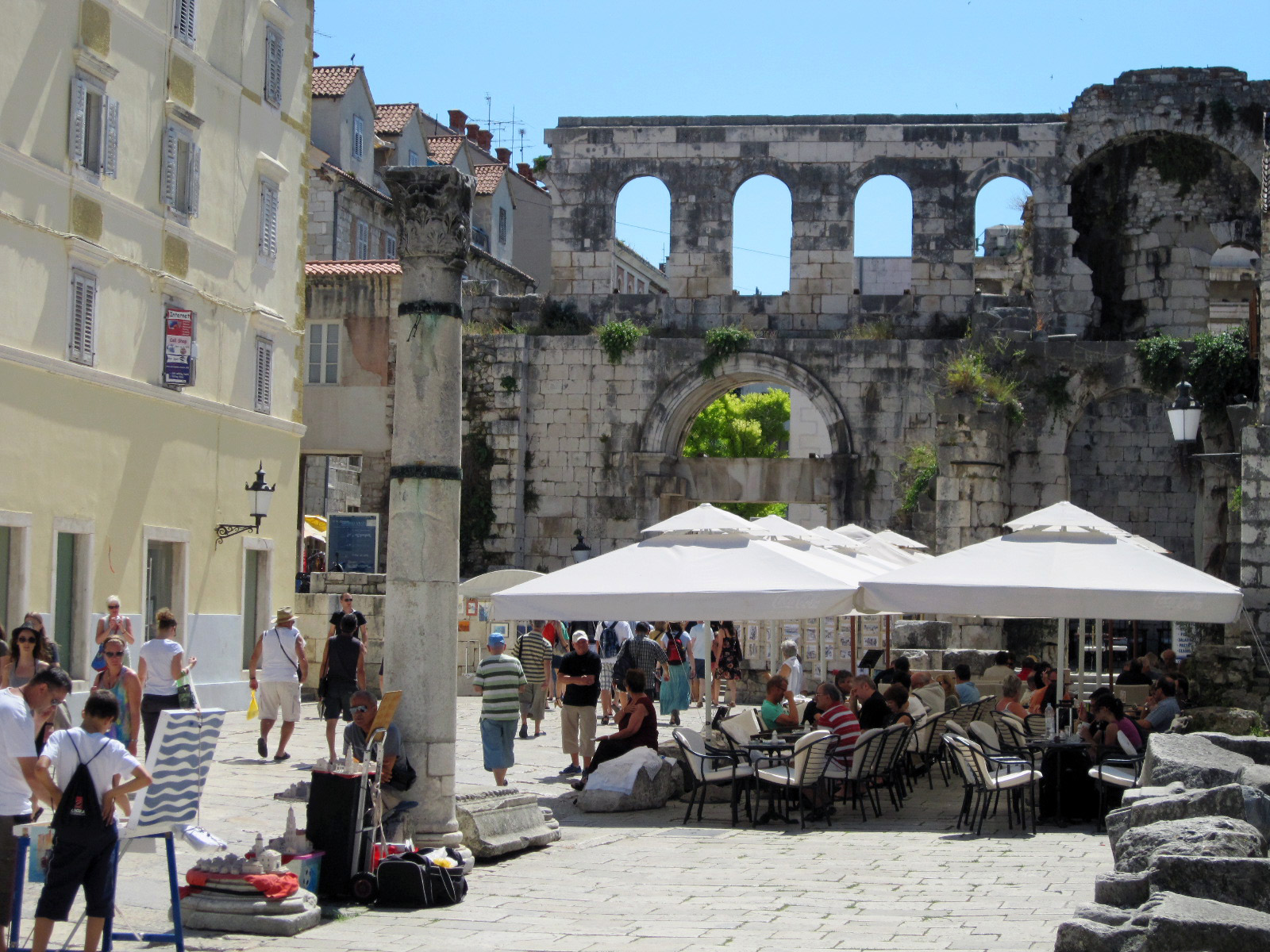 Unlike many other ancient Roman ruins that were torn down and re-used as building materials, Diocletian’s Palace has kept it’s shape, continuity and much of it’s original detail. Instead of tearing down the walls, the centuries that followed used them as a protection, building their homes inside. By the 16th century, the Palace walls protected over 200 buildings, including houses, shops, a 16th century synagogue and churches going back to the 5th century. Today there are over 3000 people living inside, sharing this amazing piece of history with souvenirs, trendy clothing, restaurants, bancomats and the daily onslaught of international tourists snapping photos at every turn. No matter which way you look there is another great photo opportunity.
Unlike many other ancient Roman ruins that were torn down and re-used as building materials, Diocletian’s Palace has kept it’s shape, continuity and much of it’s original detail. Instead of tearing down the walls, the centuries that followed used them as a protection, building their homes inside. By the 16th century, the Palace walls protected over 200 buildings, including houses, shops, a 16th century synagogue and churches going back to the 5th century. Today there are over 3000 people living inside, sharing this amazing piece of history with souvenirs, trendy clothing, restaurants, bancomats and the daily onslaught of international tourists snapping photos at every turn. No matter which way you look there is another great photo opportunity.
Some of the ancient buildings require an entrance fee but most of the Palace is entrance FREE. It is a living neighborhood after-all.
The 3rd century Mausoleum of the Emperor Diocletian and his wife, Prisca was transformed into the 5th century Cathedral of Saint Duje (the 3rd century bishop of Salona). However, the transformation didn’t change much. Inside it still looks like a Roman Mausoleum. The gold of the domed ceiling was stripped away and there were probably other beautiful wall treatments removed but the shape, the classical lentils and columns and the floors are all original. Bravo to the Cathedral for it’s respect to the old building. It’s kind of ironic through, since Diocletian was well known for his persecution of the early Christians. But there you have it.
The church also kept the Temple of Jupiter in original condition. They just replaced the statue of Jupiter with Saint Duje and added a baptistery font. The ancient coffered 3rd century ceiling of the Temple was water tight until the 1940’s when a tin room was put over the top. It’s been the baptistery of the St Duje since the 5th century.
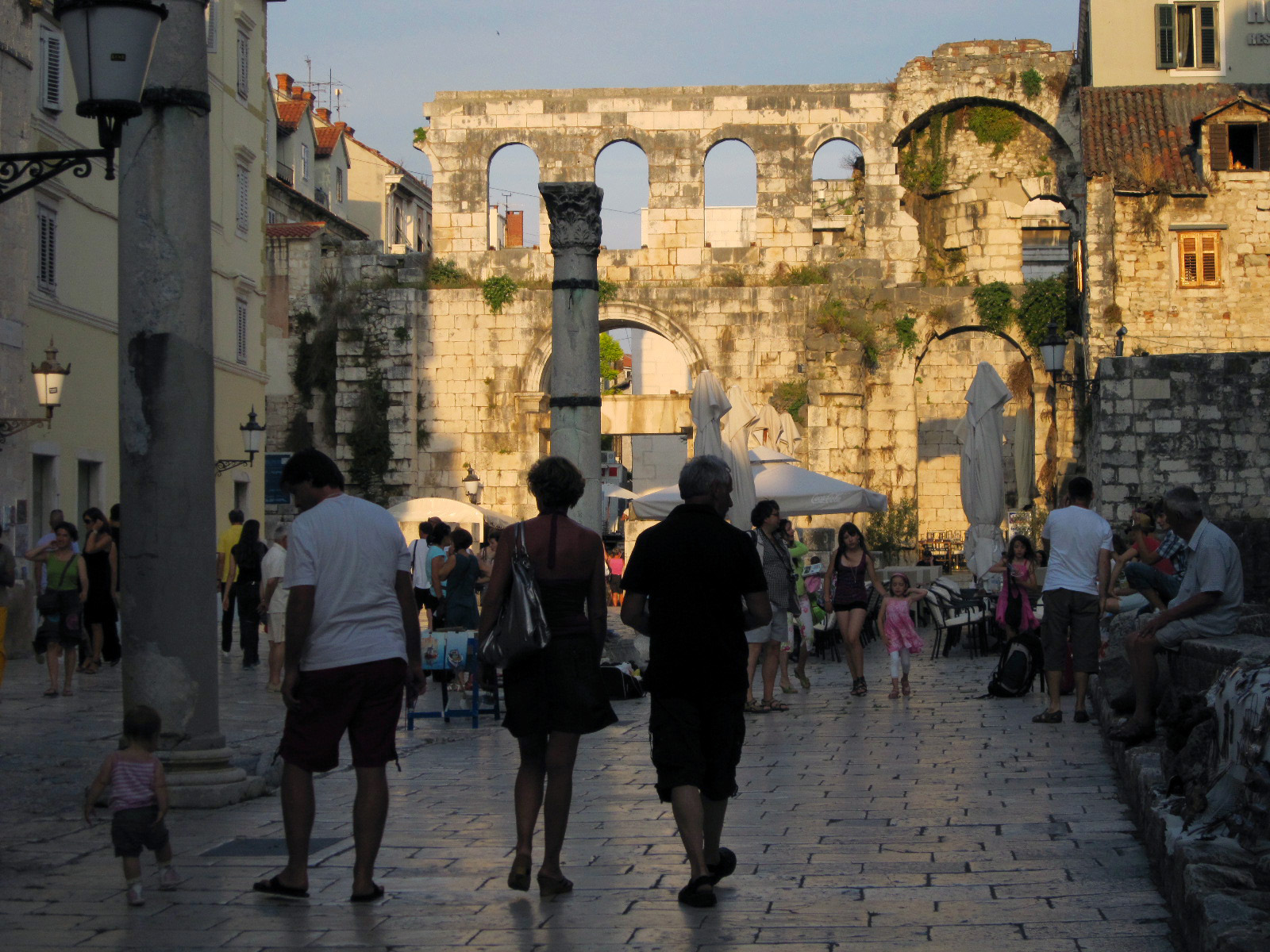 The great Prothyron Arch and the giant domed vestibule that led to the Emperor’s Private Palace (now the Ethnographic Museum) are still here. The 4 original entrance gates to the Palace still exist, so do the North/South street (the Cardo) and the East/West street (the Decumanus).
The great Prothyron Arch and the giant domed vestibule that led to the Emperor’s Private Palace (now the Ethnographic Museum) are still here. The 4 original entrance gates to the Palace still exist, so do the North/South street (the Cardo) and the East/West street (the Decumanus).
The remains of the black granite Sphynx Diocletian brought back from Egypt (currently under wraps for restoration) still sits at the entrance into the Vestibule. The Peristyle courtyard, a beautiful sunken terraced courtyard surrounded by columns and arches was, and still is the heart of the old Palace.
 During the days the Peristyle courtyard is filled with tourists, locals and vendors. At night the visitors take their seats on the terraced steps and listen to live music under the reflection of the ancient buildings glowing behind soft amber light.
During the days the Peristyle courtyard is filled with tourists, locals and vendors. At night the visitors take their seats on the terraced steps and listen to live music under the reflection of the ancient buildings glowing behind soft amber light.
Through the ancient Brass gate (the southern gate) that arrived into the Palace from the sea, is a grand barreled hall where cargo was once brought in and stored. It does keep nice and cool down here. These days it’s the location for local artisans to sell jewelry and assorted bowls crafted from the marble quarried from nearby mines.
Our hotel, the Marmont, is technically outside of the Palace walls, but it’s in that grey area where you can’t tell if you’re in the Palace or the 12th century old town. Wherever we are, it’s really wonderful. The room is comfortable, the view is charming, the air conditioning is so refreshing, the internet access is fast and free, the staff is wonderful and we are getting the best sleep we’ve had in weeks.
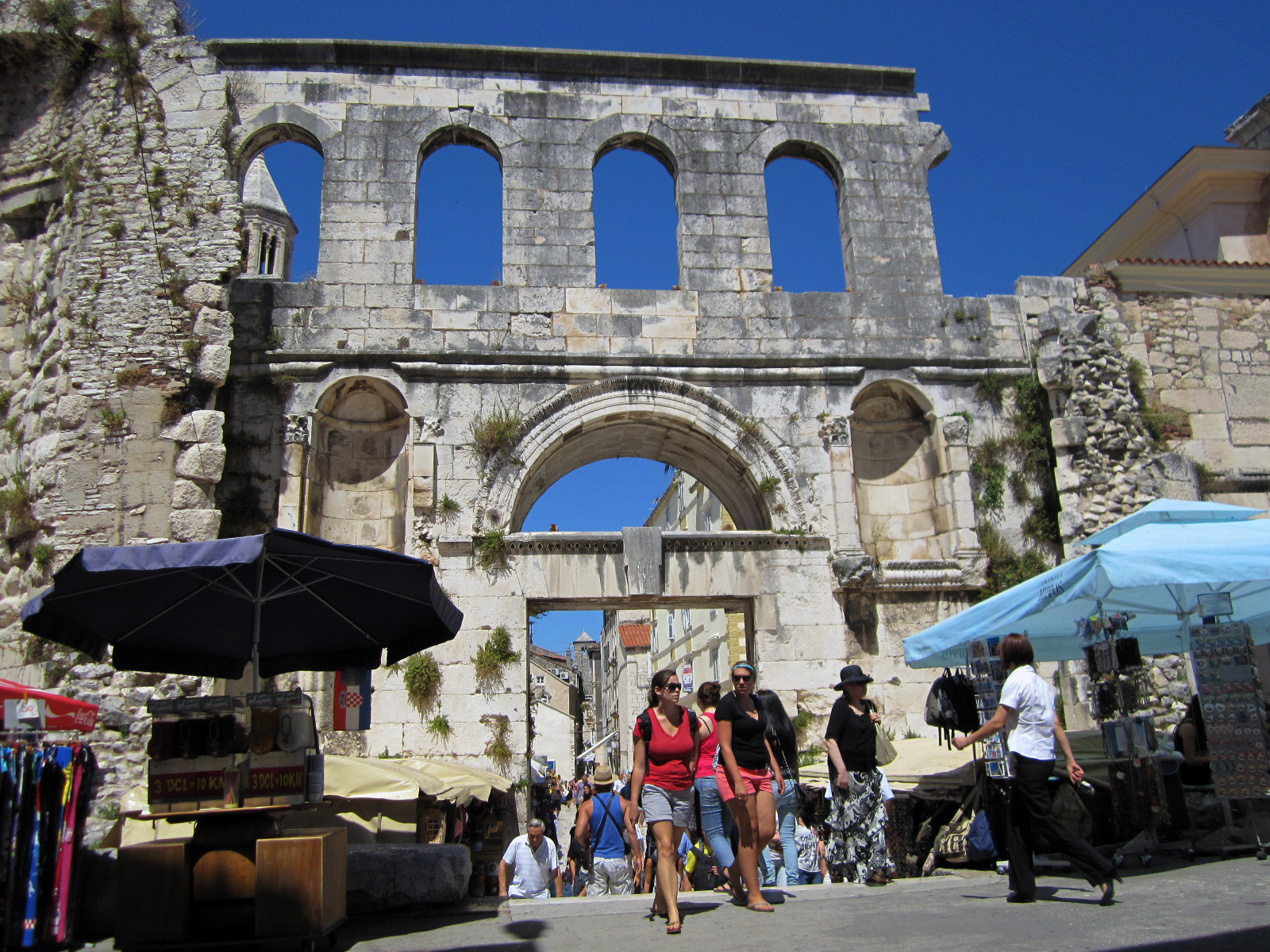 There is no end to great people watching in and around the Palace, the Riva and the old Town. This is a destination for people of all ages of all countries, young couples, old couples, families, college students and local residents. The people at the cafes and restaurants watch the people walking by and the people walking by watch the people sitting at the cafes and restaurants. They watch the ultra-high stiletto heels navigate the old stone streets. They read the t-shirts of every language. They watch the boats sailing in and out of the harbor. They watch the children chase pigeons through the stone paved squares. They watch the activity of vegetable and fish markets. And after a long day they go back to their rooms for a short pause and then come back for dinner and more entertainment.
There is no end to great people watching in and around the Palace, the Riva and the old Town. This is a destination for people of all ages of all countries, young couples, old couples, families, college students and local residents. The people at the cafes and restaurants watch the people walking by and the people walking by watch the people sitting at the cafes and restaurants. They watch the ultra-high stiletto heels navigate the old stone streets. They read the t-shirts of every language. They watch the boats sailing in and out of the harbor. They watch the children chase pigeons through the stone paved squares. They watch the activity of vegetable and fish markets. And after a long day they go back to their rooms for a short pause and then come back for dinner and more entertainment.
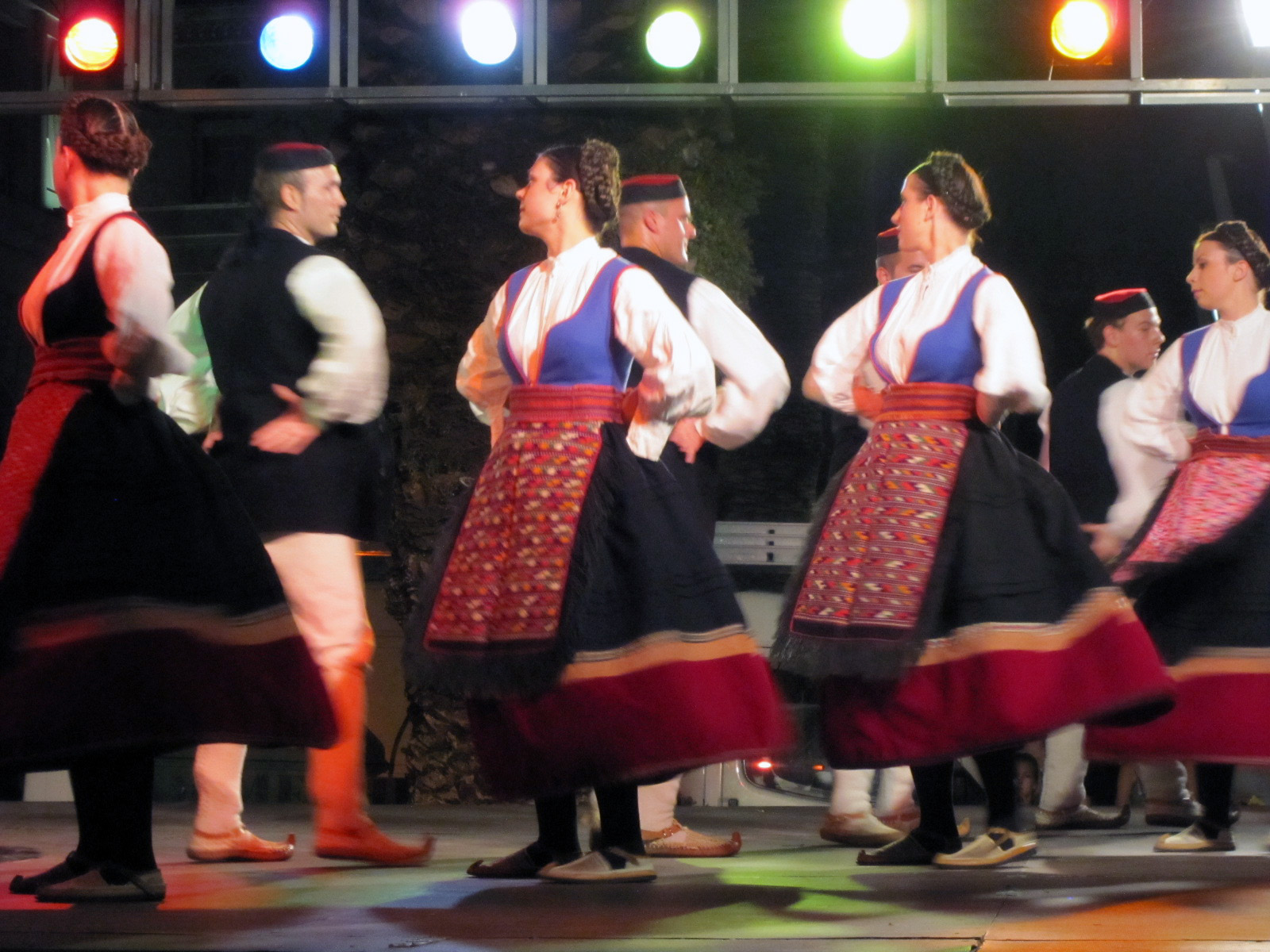 We’re here one week prior to the annual summer festival. The larger performance is in rehearsal but the smaller stage is filled each night with ethnic dancing and local cultural bands.
We’re here one week prior to the annual summer festival. The larger performance is in rehearsal but the smaller stage is filled each night with ethnic dancing and local cultural bands.
The Operas used to be staged in the Peristyle but the square is undergoing some renovation these days, so the Opera season has moved to the Republic Square just off the Marmontova. The staging (scenery, lighting and audio) is loading in for Othello and last night we saw the first rehearsal with cast and orchestra. Aside from the stages, the more intimate entertainment is over at the Peristyle square as folk rock musicians entertain the crowd. The visitors (like us) sit on the steps of the square and sing along to favorite tunes from the 60s through the 90s.
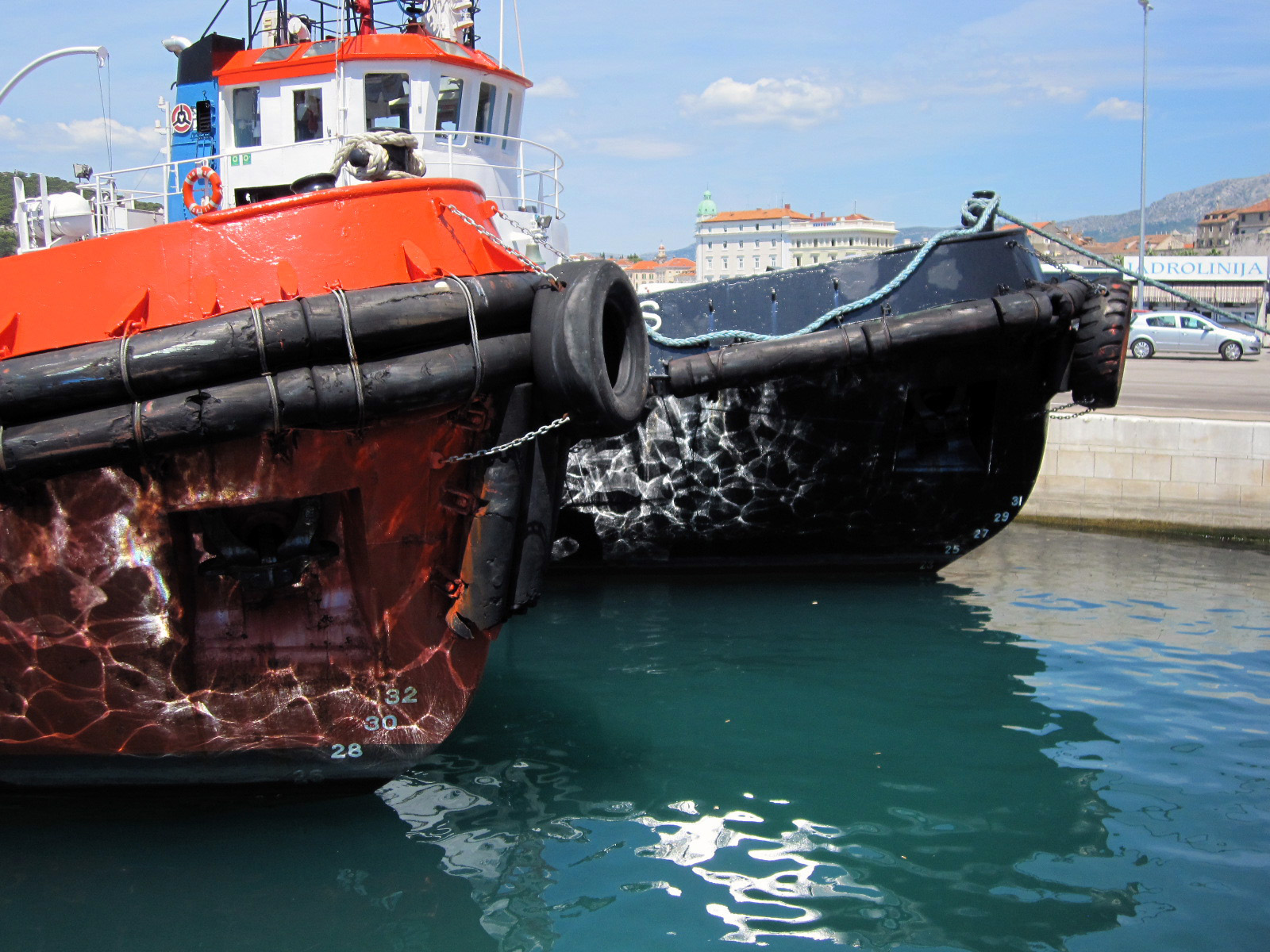 The transportation hub near the harbor is called the Lazaretti. It’s a large sprawl of bus terminals, boat docks, the train station, and ferry terminal. The name comes from the original Lazaretto was the quarantine facility for merchants and their goods. Merchants (and occasionally sailors) would need to spend 40 days here before it was determined they (and their goods) were clean of pests or disease. The Italian word for 40 is “quaranta”. Quarantine = quaranta.
The transportation hub near the harbor is called the Lazaretti. It’s a large sprawl of bus terminals, boat docks, the train station, and ferry terminal. The name comes from the original Lazaretto was the quarantine facility for merchants and their goods. Merchants (and occasionally sailors) would need to spend 40 days here before it was determined they (and their goods) were clean of pests or disease. The Italian word for 40 is “quaranta”. Quarantine = quaranta.
Walk along the Marjan to the Mestrovic Gallery
We walked away from the old town towards the Marjan Park above the old city to the Archeology Museum (it was closed). The Ivan Mestrovic Gallery, which was our intentional destination anyway, was just another 15 minutes away and it was a beautiful walk, mostly along the water.
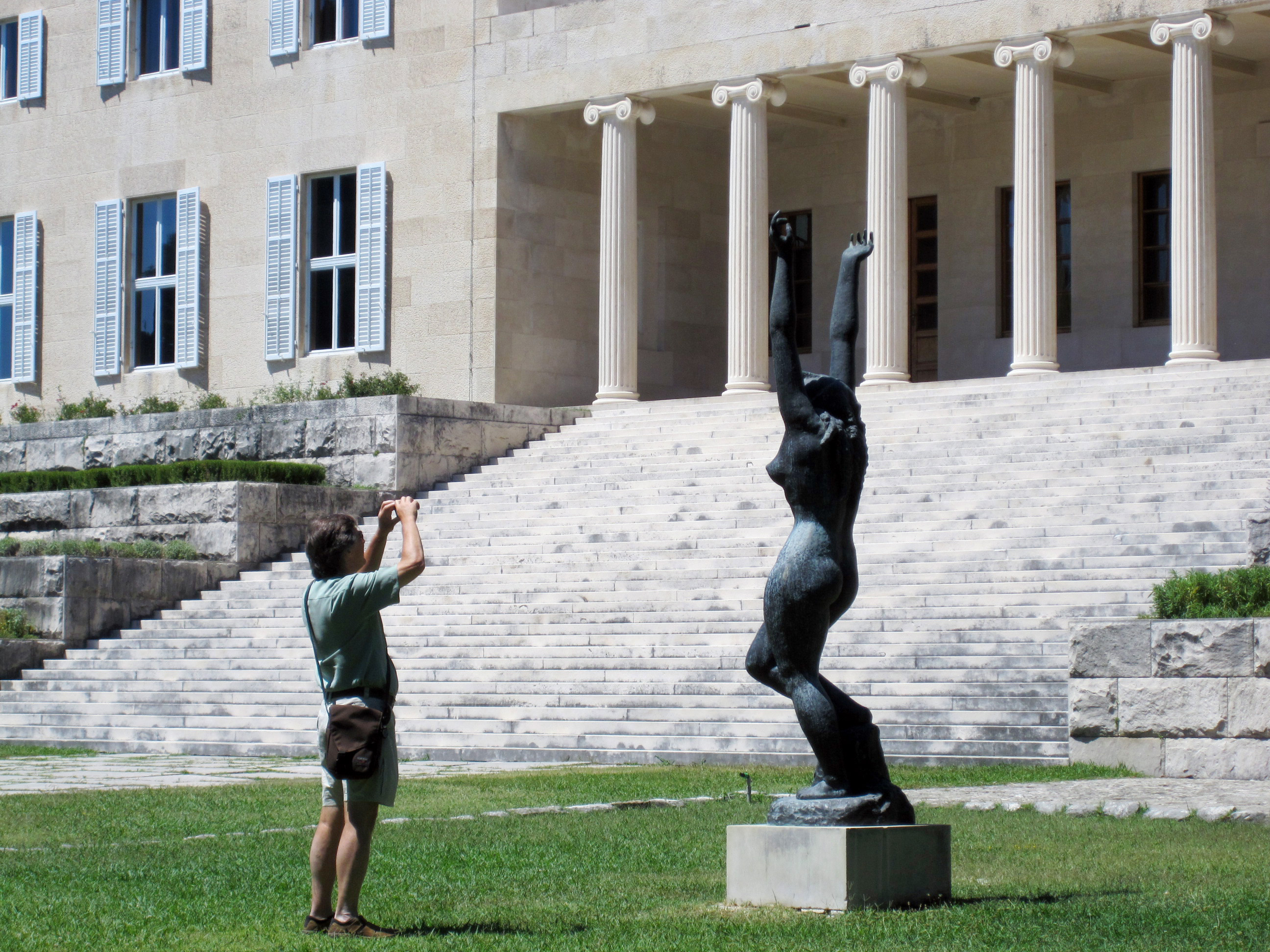 Ivan Mestovic (1883-1962) was the only man to ever have a one man show at the Metropolitan Museum in New York during his lifetime. He built his home in Split as a home and gallery and in his later years and then donated the building to Croatia. It now houses a permanent (really wonderful) collection.
Ivan Mestovic (1883-1962) was the only man to ever have a one man show at the Metropolitan Museum in New York during his lifetime. He built his home in Split as a home and gallery and in his later years and then donated the building to Croatia. It now houses a permanent (really wonderful) collection.
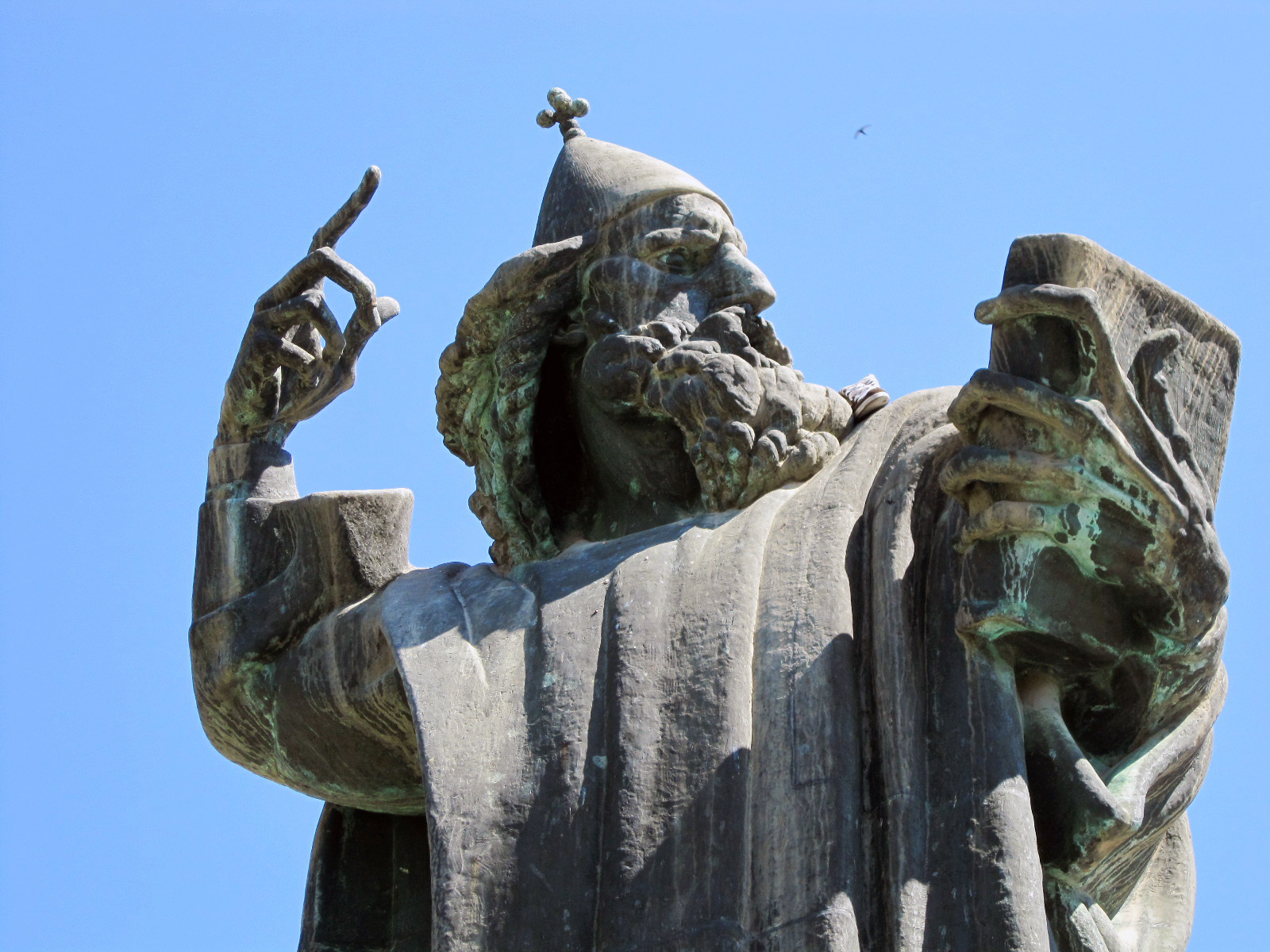 In Split, Mestrovic is most famous for the statue of Gregorius of Nin (the 10th century Croatian bishop) that stands by the Golden Gate of Diocletian’s Palace. The left foot of the statue is polished from people rubbing it for good luck.
In Split, Mestrovic is most famous for the statue of Gregorius of Nin (the 10th century Croatian bishop) that stands by the Golden Gate of Diocletian’s Palace. The left foot of the statue is polished from people rubbing it for good luck.
The bishop statue is big and very impressive but the pieces at the Mestovic Gallery are well worth the visit.Mestrovic emigrated to the US after WWII and taught in Universities from Syracuse to Notre Dame.
We walked to the Lazaretti and bought two tickets on the local bus to Trogir, another UNESCO Heritage city. It was a 35 minute nauseating ride as we listened to old Croatian women screech and cackle around us. The ride cost about $4/person. The entertainment value was priceless.
Although the town dates back to the 3rd century Roman city, Tragurium, it’s now a well preserved mixture of Romanesque churches, the Renaissance Lucic Palace, the 15th century Kamerlengo Fortress and lots of 15th-17th century houses. The only damage it has ever seen was in 1420 when the Venetians bombarded it into submission. The Venetian occupation lasted till 1797.
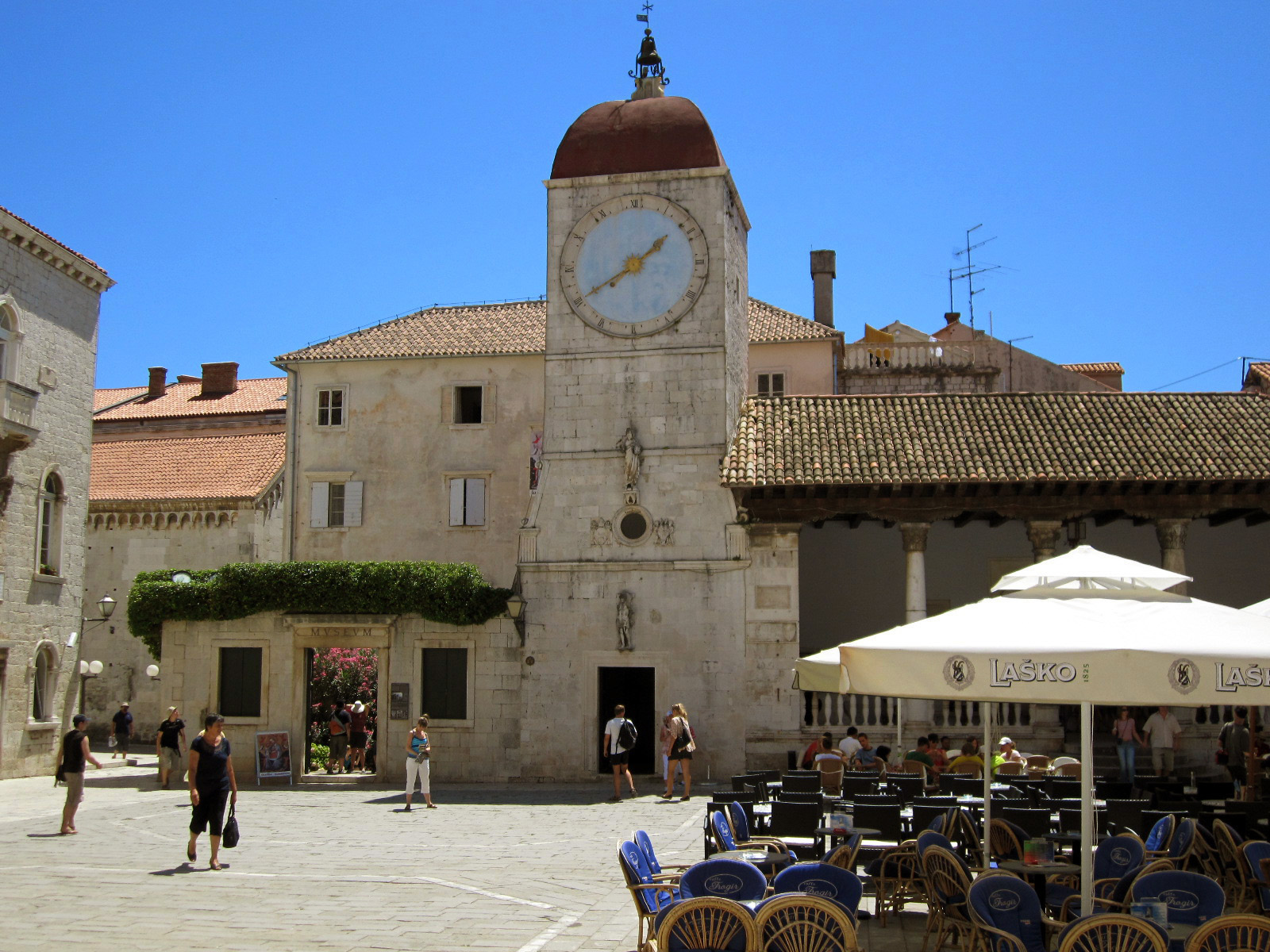 In many ways it’s similar to Split, another tranquil setting along a beautiful promenade and an old town square with tourist shops, restaurants and a church bell tower that we climbed and got the worst case of vertigo either of us has had in many years. It was one of those towers built for vertigo, open sides and small steps.
In many ways it’s similar to Split, another tranquil setting along a beautiful promenade and an old town square with tourist shops, restaurants and a church bell tower that we climbed and got the worst case of vertigo either of us has had in many years. It was one of those towers built for vertigo, open sides and small steps.
The treasure (or one of the treasures) of Trogir is “The relief of Kairos”, a 3rd century stone relief of the Greek god Kairos, god of the happy moment, discovered in an abandoned house in 1928. Kairos is the ancient Greek expression for “the opportune moment”, the instant between sequential time when something really magical happens. Chronos is “quantitative time”, Kairos is “qualitative time”. The treasure is now kept in the Benedictine nunnery with the church of St. Nikola. We never saw it. The “opportune moment” never showed itself.
Many people think of Croatia as a poor war torn country. The war with the Serbs was complicated and long; something that was brewing since before World War I. Tito held everything in control under his iron fist, but when Croatia declared independence in 1990, the Croatian Serbs rebelled and all shit broke out for about 5 years till the 1995 Dayton Accord was signed in Paris. It’s been pretty quiet since then. We saw very few scars from the 1990s war and very little evidence of a Soviet style communist country.
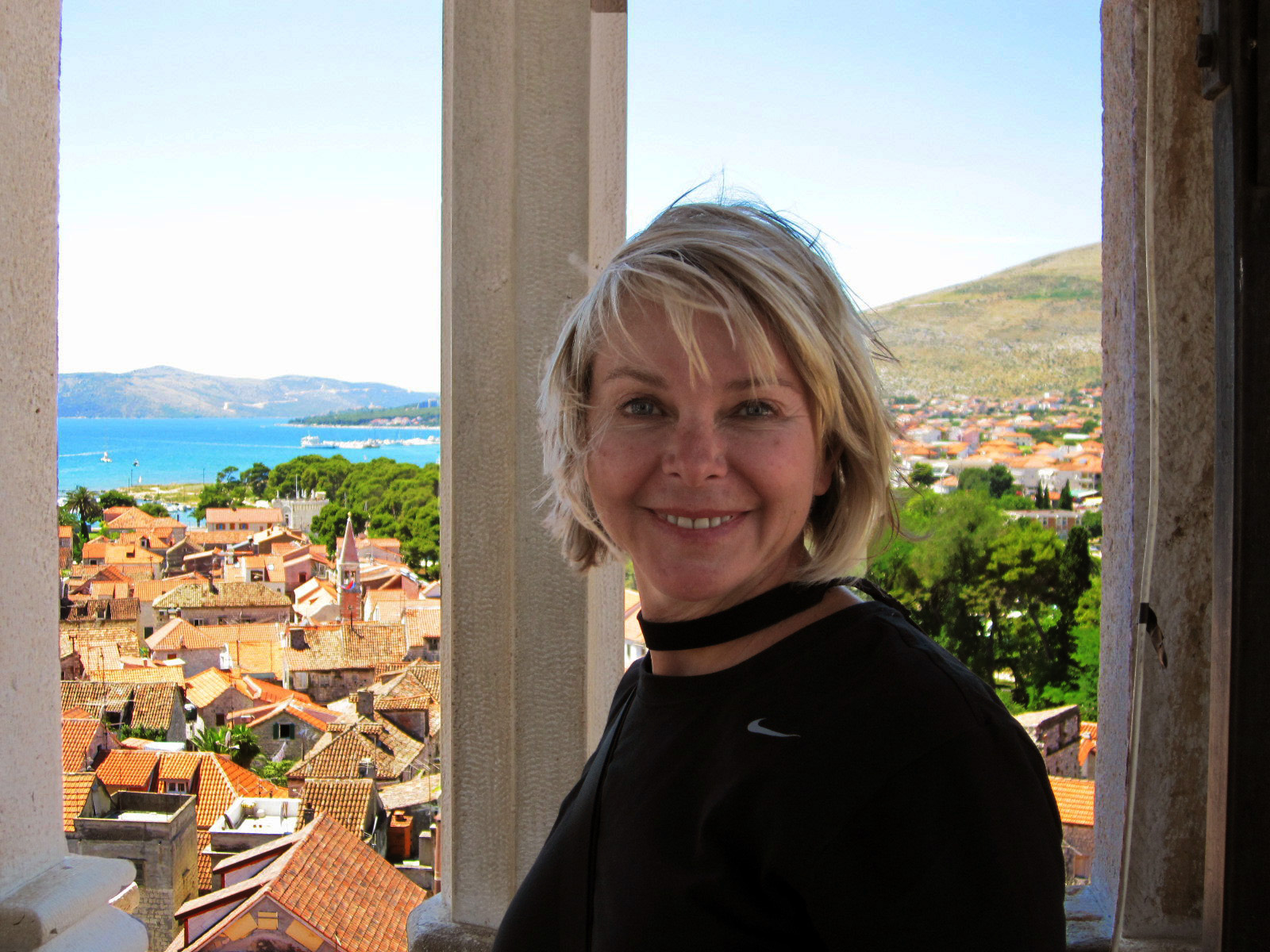
You must be logged in to post a comment.